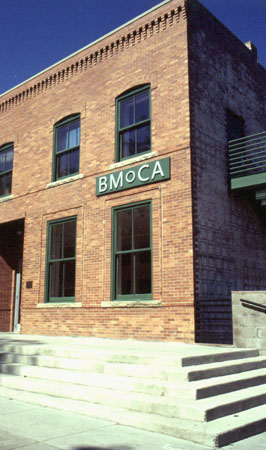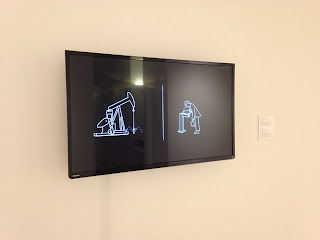 A great little show at Boulder Museum of Contemporary Art (BMoCA) just ended this past week, titled Craft Tech / Coded Media: women, art & technology.
The show was curated by Deanne Pytlinksi, a professor of Art History,
Theory and Criticism at Metropolitan State University in Denver.
Pytlinksi has always been interested in gender and video art throughout
her career, having wrote her dissertation on the subjects, and continued
to examine the role of gender in technology in this exhibition. Through
the lens of contemporary female artists, some of whom were early
pioneers of video art and multi-channel installations, Pytlinksi seeks
to question the relationship between gender and technology in an
increasingly digital age. Below are some highlights I found particularly
interesting.
A great little show at Boulder Museum of Contemporary Art (BMoCA) just ended this past week, titled Craft Tech / Coded Media: women, art & technology.
The show was curated by Deanne Pytlinksi, a professor of Art History,
Theory and Criticism at Metropolitan State University in Denver.
Pytlinksi has always been interested in gender and video art throughout
her career, having wrote her dissertation on the subjects, and continued
to examine the role of gender in technology in this exhibition. Through
the lens of contemporary female artists, some of whom were early
pioneers of video art and multi-channel installations, Pytlinksi seeks
to question the relationship between gender and technology in an
increasingly digital age. Below are some highlights I found particularly
interesting.
 |
| Lynn Hershman Lesson, Room of One's Own, 1990-1993 video still from interactive installation, print: 30 x 40 in. |
In this piece by Lynn Hershman Lesson, we see the image of a cyborg seductress from her Cyborg series. Emerging in late 20th-century science fiction, the term "cyborg," when applied in popular culture, refers to a part human/part robot character that has enhanced abilities due to technology (think Inspector Gadget, Star Trek, and RoboCop). The idea conveys a concern over the increasing digital culture at the time and the fear that technology could/would take over nature (an issue that continues to proliferate our world today). As Lesson explains in the show, feminists surprisingly embraced the cyborg as a means to separate the relationship between women and nature, a "clique" association which feminists felt women were subjected to. Lesson's cyborg above shows a figure that meets conventional beauty standards and holds a glamor reminiscent of old Hollywood movies. Despite her captivating gaze, the woman is pointing a gun directly at her viewer (us) in a dangerous yet seductive way. Lesson further supports this framework with the title of her work, "A Room of One's Own," the title of Virgina Woolf's extended essay published in 1929 (and one of my favorite books). This title conjures up images of the beautiful and quiet women depicted in Impressionist paintings of the late 18th-century, of ladies in waiting and of the overall expectations of women in society. Still, all of the points Lesson engages with in this piece continue to hold a lot of relevance in society today.
 |
| Krysten Cummingham, Tapestry X, 2013, cotton, dye, galvanized steel, wire |
|
Krysten Cunningham's fiber structure, made up of 8 hanging screens woven from everyday synthetic material, was created by the artist as a site-specific installation for BMoCA. Known for her work in sculpture and video, Cunningham's interest lies in crafts of the 1960's- 1970's as well as "utopian mathematical and scientific theories in geometric forms," according to Pytlinksi. Working with a heavily gendered material that is native to our idea of women and their history, Cummingham combines the woven tapestry with color palettes taken from computer graphics. (The work is shown next to one of her video works, 3 to 4 from 2010). Through this piece, Pytlinksi communicates the artist's efforts to re-gender the modernist era of science and architecture that was dominated almost entirely by men.
 |
| Barbara Hlali, Painting Paradise, 2008 animation (gouache on TV screen and video stills) 5:30 min. |
Barbara Hlali, who's work is shown above, is a multi-media artist creating experimental animations that speak to political conflict. This animation shown in the exhibition, Painting Paradise, takes footage from real media showing the wall between Shiite and Sunni neighborhoods in Baghdad, Iraq. Utilizing digital images seen in the media and the artistic technique of applying brushstrokes to a canvas, Hlali mimics the tactics used by Iraqi's to cover up their country's broken infrastructure with posters that depict blissful landscape scenes. We learn from Pytlinks's synopsis of the work that in Painting Paradise, the artist effectively "demonstrates that any attempt to mask the realities of war cannot be sustained."
Other exhibition shots:
 |
| Lynn Hershman Lesson, (left to right): Digital Venus after Titian (1996), TV Legs (1990), Seduction (1998), Wrapped (2007) |
|
|
 |
| Marina Zurkow, Mesocosm (Wink, Texas), 2012, custom soft-ware driven, hand-drawn animation, 144-hr cycle, dimensions variable | | |
|
|
|
|
|
|
 |
| Beryl Korot, Yellow Water Taxi, 2003, single-channel video, 2 min., stereo sound |
 |
| Beryl Korot, Babel 2, 1980, oil painting on hand-woven canvas |
 |
| Marina Zurkow, Slurb, 2009 |
Marina Zurkow, The Thirsty Bird, 2012, HD video animation, black and white, silent video player, 8:12 min. loop
Full list of exhibiting artists include: Krysten Cunningham (b. 1973) , Susan Hazaleus (b. 1951), Lynn Hershman Lesson (b. 1941), Barbara Hlali (b. 1979), Beryl Korot (b. 1945), Marina Zurkow (b. 1962), and Kelly Monico.
 A great little show at Boulder Museum of Contemporary Art (BMoCA) just ended this past week, titled Craft Tech / Coded Media: women, art & technology.
The show was curated by Deanne Pytlinksi, a professor of Art History,
Theory and Criticism at Metropolitan State University in Denver.
Pytlinksi has always been interested in gender and video art throughout
her career, having wrote her dissertation on the subjects, and continued
to examine the role of gender in technology in this exhibition. Through
the lens of contemporary female artists, some of whom were early
pioneers of video art and multi-channel installations, Pytlinksi seeks
to question the relationship between gender and technology in an
increasingly digital age. Below are some highlights I found particularly
interesting.
A great little show at Boulder Museum of Contemporary Art (BMoCA) just ended this past week, titled Craft Tech / Coded Media: women, art & technology.
The show was curated by Deanne Pytlinksi, a professor of Art History,
Theory and Criticism at Metropolitan State University in Denver.
Pytlinksi has always been interested in gender and video art throughout
her career, having wrote her dissertation on the subjects, and continued
to examine the role of gender in technology in this exhibition. Through
the lens of contemporary female artists, some of whom were early
pioneers of video art and multi-channel installations, Pytlinksi seeks
to question the relationship between gender and technology in an
increasingly digital age. Below are some highlights I found particularly
interesting.












No comments:
Post a Comment